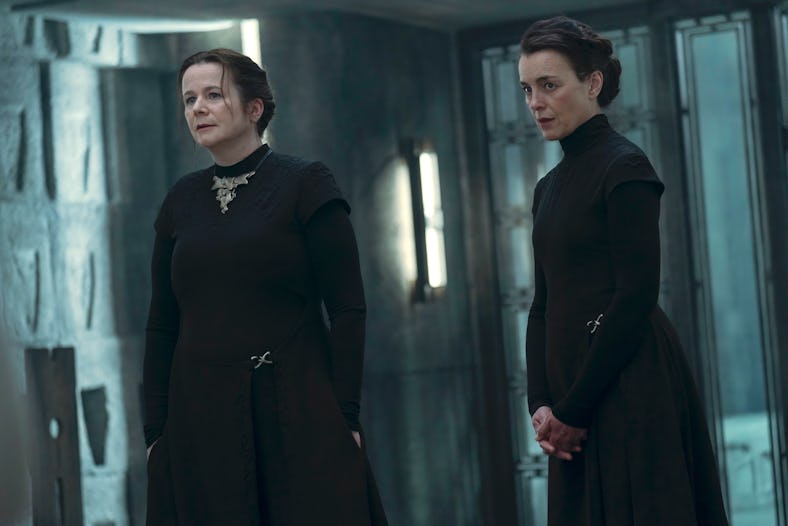The Future of Dune Lies in the Past
The new HBO series is a prequel to all of Dune — but for these characters, the path is still uncertain.

If there’s one thing that the folks behind Dune: Prophecy want, it’s for the audience to feel welcome. Notorious for a perception of denseness and complexity, the barrier to entry into Dune has, historically, felt like a fictional world that required a bunch of homework ahead of time. But in a TV age in which other prestige fantasy shows are derived from the appendices of famous novels, Dune: Prophecy’s advantage is that although it's based on whole books, it's not entirely beholden to fan expectations, nor does it assume you’ve read everything. It’s a prequel, but it’s equally its own thing.
“For us, it’s impossible to approach it like that,” Chris Mason tells Inverse. His sword-swinging character is Keiran Atreides, a distant ancestor of Leto and Paul. “They become part of that Dune canon, which has been really exciting. But, for us it's new and it's something we are very much in the present with our characters.”
This comment is an interesting microcosm of the tension within the new series. The series, which follows sisters Valya (Emily Watson) and Tula Harkonnen (Olivia Williams) as they seek to expand the power of the Sisterhood (soon to be Bene Gesserit) in order to control the throne, packs each episode with massive twists — twists that will shape the distant future of the classic Dune narrative. But how does it all work? And what exactly is the “Prophecy” in Dune: Prophecy? Inverse caught up with the cast, showrunner, and producer to sift through the sands for the answers.
Beyond the Dune books
Keiran Atreides (Chris Mason) and Princess Ynez (Sarah-Sofie Boussnina) will create the future of Dune, but right now, they don’t know it.
Dune: Prophecy takes place 10,148 years before the birth of Paul Atreides (Timothée Chalamet) from the first Dune movie. Stylistically, fans will notice right away that this show is clearly intended to be in the same universe as the new films. That’s because here, thanks to a very specific technology ban, a 10,000-year gap doesn’t mean radical, aesthetic change. “We view ourselves in the universe that Denis [Villeneuve] put on screen,” showrunner Alison Schapker tells Inverse. “But at the same time, we are absolutely inspired by the sort of, not just Frank Herbert's vision, but Brian Herbert's extension of that world, and Kevin J. Anderson’s novel; Sisterhood of Dune. That was very seminal for us. Our characters come from that novel.”
Indeed, the lead sister characters of Valya Harkonnen (Emily Watson) and Tula Harkonnen (Olivia Williams) come from that 2012 prequel novel, as well as its sequel, the 2014 book Mentats of Dune. This “Schools of Dune” series fleshes out the background of the very early days of the Imperium in the Dune universe, following a big AI uprising called The Butlerian Jihad. Frank Herbert invented the Bene Gesserit Sisterhood, the Butlerian Jihad, and all the other movers-and-shakers of Dune back in the 1960s, but these details come from the newer books. If fans feel like the lore in Dune: Prophecy has been around for a long time, they shouldn’t. And, as Schapker points out, in the new series, even the events of the prequel novels aren’t the whole story.
“Our young Valya Harkonnen [played by Jessica Bardem in flashbacks], who’s our Mother Superior of the Sisterhood — that is more [from the] book,” Schapker explains. “And then, Emily Watson, who is the adult more mature leader version of Valya, that’s our bit, where we’re extrapolating.”
What is the Prophecy in Dune: Prophecy?
The Sisterhood, just moments before the first prophecy arrives.
The biggest mystery behind Dune: Prophecy lies in its title: What, exactly, does it predict?
“In the beginning of this series, we see [Valya and Tula] poised to be in control of absolutely everything,” Emily Watson tells Inverse. “But then the pieces start slipping out from under them and things start moving very quickly. Because suddenly this mystery has appeared that they can't solve. And that really drives the collapse of their control.”
Without getting into spoilers that are too big, that mystery exists in the form of a brand-new character named Desmond Hart, who creates problems for the plans of the Sisterhood. And therein lies one interpretation of the word “Prophecy.”
“Mother Raquella, the founder of The Sisterhood, foretells this reckoning that is going to come, that it could wipe out the Sisterhood and the Imperium at large,” executive producer Jordan Goldberg explains. “And young Valya concocts this plan to save The Sisterhood and the Imperium. So, a large part of what the present-day story is the reckoning kind of slips in the back door in the form of Desmond Hart.”
In one sense, the Prophecy in Dune: Prophecy is about a massive holy judgment that has arrived several centuries early. But, there’s also more than one prophecy at play here. In the first Dune novel, there are famous references to “plans within plans,” but in Dune: Prophecy, there are essentially adaptations within adaptations, and that means there are prophecies on top of prophecies. The immediate prophecy in the show is about the dreaded “Tiran Arafel,” the reckoning that Mother Raquella warned Valya about. But Dune fans will note that a different reckoning could be coming even further in the future, including the reign of Paul Atreides and even his heirs.
“We start with kind of a straightforward prophecy as much as a prophecy could ever be straightforward,” Schapker says. “But then it develops, and there are new questions. Who believes it and who doesn't? Is it weaponized? Is it distorted? I think the ‘prophecy’ is as much about Desmond Hart coming into the show as it is about the far, far future. But, I would say that is not the end of how we will examine prophecy in this show.”